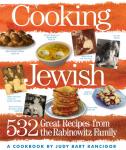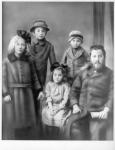
BUY COOKING JEWISH by clicking here now.
Simple feasts for every holiday
from The Canadian Jewish News
September 22, 2005
by Judy Bart Kancigor
When food writers Louise Fiszer and Jeannette Ferrary decided to collaborate on a Jewish cookbook, they wanted to include tasty, cherished holiday recipes that honor age-old traditions, yet were tailored to today’s busy, health-conscious cook. But as one traditional Jewish cook warned them, “Don’t do anything too weird…. Nobody wants to be eating experiments, especially on the High Holy Days.”
As they say, good things come in small packages, and now just in time for Rosh Hashanah comes “Jewish Holiday Feasts” (Chronicle Books), a charming little book, delightfully illustrated by Coco Masuda, now available in hard cover.
The 39 recipes are arranged by season and then by holiday. “The foods of all of these holidays are representative of the season,” Fiszer explained. “Plums don’t grow in the winter. My philosophy is cook what’s fresh and now. It will never taste better later.”
Where moms and grandmas of yesteryear spent days in the kitchen preparing for the holidays, today’s cooks look for simple recipes that rely on fresh ingredients. “I’ve been a cooking instructor for close to 30 years, and I can tell you,” said Fiszer, “everybody wants simplicity. The star chefs that teach - nobody goes home and makes those recipes. People love watching them cook, but students of cooking need to have simplicity.”
Fresh seasonal ingredients infuse traditional holiday fare to create memorable contemporary menus: Asparagus and Herbed Cheese Strudel for Shavuot, Rolled Turkey Breast with Mushroom-Spinach Stuffing for Passover, and for Hanukkah you’ll find Zucchini Latkes, Fresh Salmon Latkes, Cauliflower and Carrot Latkes and Sweet Cottage Cheese Latkes as well as the traditional Classic Potato.
“Today health has to be a factor,” said Fiszer by phone from her California Bay Area home. “The brisket recipe, for example, one of the most popular recipes in the book, was a mix of my mother’s and Julia Child’s, believe it or not. My mother would brown it in fat, despite the fact that there’s a whole layer of fat on the meat, and then add the vegetables. I trim the fat and put it in a dry pot with some liquid and vegetables. There’s plenty of fat to go around. I also generally use olive oil. That’s another accommodation.”
A brief history and explanation of each holiday introduce the simple and straightforward recipes, making it the perfect gift for those new to Judaism as well as a compact, little primer for anyone wishing to brush up. “Jews by choice will find it especially helpful,” said Fiszer. “I don’t mean kashruth, although all the recipes are of course kosher. They want to know, what is Jewish holiday food. It’s laid out very easily to help you understand Jewish holiday cuisine.”
For Rosh Hashanah, for example, we learn that each name for the holiday reflects a different aspect of the significance of this holy day. Yom ha-Din refers to the Day of Judgment, “a time of examination, evaluation, and repentance”; Yom ha-Zikaron, the Day of Remembrance, signifying “the eternity of time and the continuity of past and present”; and Yom Teruah, the Day of the Blowing of the Horn, recalling the sounding of the shofar, “a reminder of spiritual awakening.”
Traditionally on Rosh Hashanah we include new fruits of the season. “We use figs, pomegranates, persimmons, avocados and apples rather than just for show - which I do anyway in a centerpiece - but I love to incorporate these fruits in my recipes.” A sweet-tart Persimmon and Pomegranate Salad begins the feast, signifying “the wish for fruitfulness and plenty in the new year.”
Fiszer and Ferrary researched traditional Jewish cuisine the world over. The Rosh Hashanah menu includes Ashkenazic Braised Apples and Red Cabbage with Wine as well as Sephardic Couscous with Saffron and Vegetables.
A Round Raisin Challah, de rigueur on the Rosh Hashanah table, is one of many shapes for the new year. Some form the bread into the wings of angels or into a ladder, signifying the wish that our prayers may reach heaven. “We use a round challah, rather than the traditional braiding, to represent the continuation of life,” noted Fiszer.
We use honey on Rosh Hashanah, reflecting the wish for a sweet new year. Honey and Cumin-Glazed Cornish Hens is this meal’s festive centerpiece. And of course, it wouldn’t be Rosh Hashanah without honey cake. Moist with apples and topped with almonds, Hannah’s Honey Cake is a fitting end to the holiday feast as we look forward to the sweet new year ahead.
“Hannah is the mother of one of my best friend’s,” Fiszer explained. “She was a fabulous cook. There isn’t a Jewish recipe that she didn’t make better than anybody else.”
RECIPE

